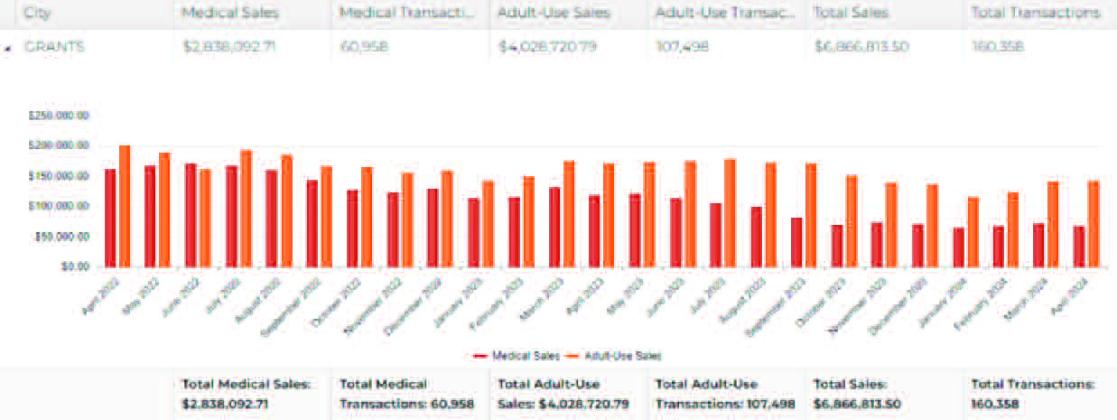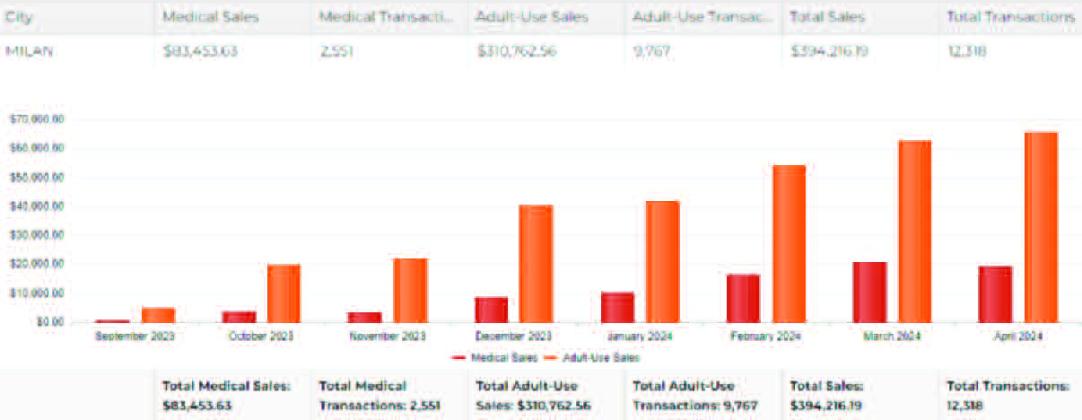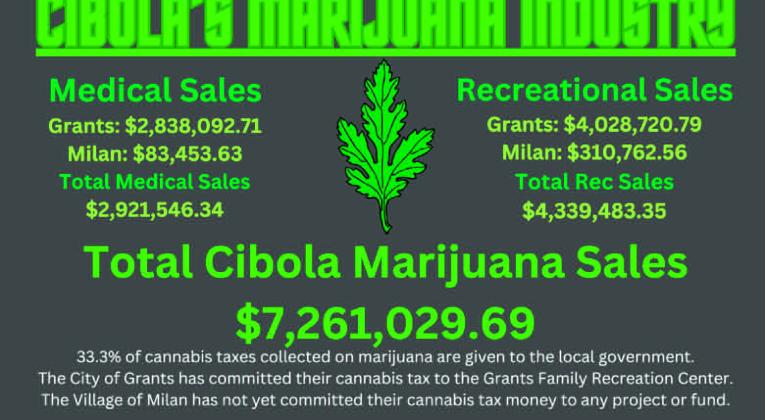CIBOLA COUNTY, N.M. – Since legalization, marijuana has rooted itself as an essential part of the economy in Cibola County. April 2024 was another successful month for the marijuana industry, providing a snapshot of the evolving trends and consumer behaviors within the local market.
The county is home to only five marijuana stores, yet, since legalization of the drug, Cibola has seen a total of $7,261,029.69 spent on the drug.
In just the month of April, $293,992.98 was spent on cannabis in Cibola.
The Forefront of Cibola’s Cannabis Commerce
Grants, the larger of the two communities, is home to three marijuana stores. Since legalization, Grants has:
• April 2024 Medical Sales: $67,039.34
• Total Medical Sales: $2,838,092.71
• Total Medical Transactions: 60,958
• April Adult-Use Recreation Sales: $142,079.75
• Total Adult-Use Recreation Sales: $4,028,720.79
• Total Adult-Use Recreation Transactions: 107,498
• Total Combined Sales Since Legalization: $6,866,813.50
• Total Transactions Since Legalization: 160,358 These figures underscore Grants' role as the county's primary marijuana market, catering to a steady stream of both medical and recreational consumers.
A Growing Market
Milan, although smaller, has shown remarkable growth since the introduction of its two marijuana stores. Despite its size, Milan's contribution to the county's cannabis industry is unmistakable:
• April Medical Sales: $19,314.06
• Total Medical Sales: $83,453.63
• Total Medical Transactions: 2,551
• April Adult-Use Sales: $65,559.83
• Total Adult-Use Sales: $310,762.56
• Total Adult-Use Transactions: 9,767
• Total Combined Sales Since Legalization: $394,216.19
• Total Transactions Since Legalization: 12,318 Milan's data reflects a burgeoning market that has grown every single month since it’s first shop opened in September 2023.
Cibola’s Marijuana Industry One of the most tangible benefits of the legalized marijuana industry in Cibola County is the generation of tax revenue.
The Cannabis Excise Tax, set at 12 percent of sales for adult-use cannabis, has become a significant source of fiscal income for the state and by extension, local communities like Grants and Milan. Medical marijuana, while not subject to this excise tax, still contributes through the Gross Receipts Tax (GRT), albeit at a reduced rate because it is taxed like prescription drugs.
Municipal governments are entitled to 33.33 percent of the tax collected from each marijuana purchase.
For Cibola County, this means a direct financial injection into local government budgets, which supports a range of public services from infrastructure projects to educational programs. As the industry grows, the potential for increased tax revenue could lead to more substantial improvements and investments at the local level.
In Milan alone, legalization has led to the establishment of two new businesses.
The Cibola Citizen reached out to the New Mexico Taxation and Revenue Department to see what this tax can be used for. According to Charlie Moore with the New Mexico Taxation and Revenue Department, the state does not have any restrictions or specifications for how the tax money collected can be spent. Communities are allowed to spend this month however they please.
In 2022 the Grants City Council voted to commit marijuana tax money they collect to the Grants Recreation Center, formerly known as Future Foundations.
Because marijuana sales are so new to the Village of Milan – they only received their first taxes from the industry in November – the government has not committed these taxes to any project or fund. Interim Village Manager Candi Williams said, “I believe the plan is to use this funding towards recreation and tourism, however nothing has been decided.”
The Legalization of Marijuana
New Mexico's journey toward cannabis legalization began in 1923 when the state prohibited the cultivation, importation, and sale of cannabis, motivated by concerns over its misuse and intoxicating effects.
In 1978, New Mexico pioneered medical cannabis legislation with the Controlled Substances Therapeutic Research Act. This act permitted medical cannabis use through a federally approved research program, although the program faced several regulatory hurdles before becoming fully operational. It was initially launched to provide relief to cancer patients, memorialized by the Lynn Pierson Therapeutic Research Program, which served around 250 patients between 1978 and 1986.
The conversation around cannabis took a significant turn in 1999 when Governor Gary Johnson openly endorsed the legalization of cannabis, advocating for a reevaluation of drug policies. This stance drew considerable controversy and opposition from various state and federal officials.
The state made a substantial legislative leap in 2007 with the passage of the Lynn and Erin Compassionate Use Act under Governor Bill Richardson, legalizing medical cannabis for various qualifying conditions and setting the stage for regulated medical cannabis use.
In 2019, New Mexico's House of Representatives passed House Bill 356, aiming to legalize recreational cannabis, although it initially stalled in the state senate. That same year, Governor Michelle Lujan Grisham marked a transformative moment for the economy by signing the Cannabis Regulation Act into law.
This new law not only legalized the cultivation and sale of recreational cannabis for adults over the age of 21 but also merged the oversight of both recreational and medical cannabis under a unified commercial framework. Since the commencement of licensed sales in April 2022, New Mexico has witnessed a rapid expansion of its marijuana industry, heralding a new era of economic opportunity and regulatory challenges.
Cibola County has since emerged as a winner in this green revolution.



